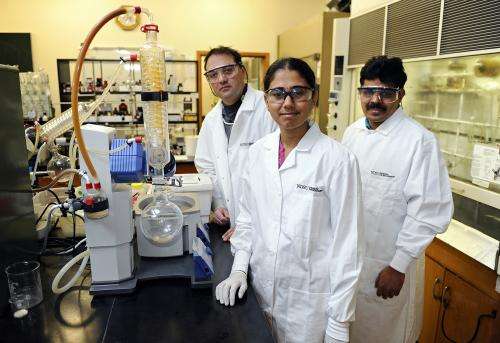Ultimate recycling: New plastic that disappears when you want it to

Plastic populates our world through everything from electronics to packaging and vehicles. Once discarded, it resides almost permanently in landfills and oceans. A discovery by researchers at North Dakota State University, Fargo, holds scientific promise that could lead to a new type of plastic that can be broken down when exposed to a specific type of light and is reduced back to molecules, which could then be used to create new plastic.
Published in Angewandte Chemie, a leading international journal, the proof of concept experiment outlines the work of researchers in the Center for Sustainable Materials Science at NDSU. The multidisciplinary team includes researchers from the Department of Chemistry and Biochemistry: Mukund Sibi, university distinguished professor; Sivaguru Jayaraman, James A. Meier professor; postdoctoral fellow Saravana Rajendran; graduate student Ramya Raghunathan; postdoctoral fellow Retheesh Krishnan; and staff scientist Angel Ugrinov; as well as Dean Webster, professor and chair of the Department of Coatings and Polymeric Materials and postdoctoral fellow Ivan Hevus.
The research team focuses on biomass, using oilseed from agricultural crops, cellulose, lignin and sucrose to generate building blocks of molecules that are made into polymers to create plastics. One of the grand challenges for the 21st century is sustainability that lessens dependency on fossil fuels. NDSU, in association with the North Dakota Experimental Program to Stimulate Competitive Research (ND EPSCoR), established the Center for Sustainable Materials Science to develop a program for the preparation of polymers and composites using biomass, a renewable resource.
"Real sustainability involves breaking it back into the building blocks. We have shown that we can break it down into the building blocks and re-make the polymer," said Dr. Sibi.
In their proof of concept experiment, the group used fructose, found commonly in fruit, to create a solution of molecules, which was then converted to a plastic (polymer). By exposing the plastic to ultraviolet light at 350 nanometers for three hours, researchers degraded the plastic, reducing it back to the soluble building block molecules from which it began.
Plastics usually don't decay for hundreds of years, creating solid waste issues. They generally degrade slowly, potentially leaching chemicals into the environment or creating toxins in the air when burned.
"This cradle-to-cradle approach to create a plastic which can be degraded easily offers scientific potential for eventual products that could lessen dependence on fossil fuels and decrease the amount of raw materials needed," said Dr. Webster.
"Our strategy has the potential to build novel materials from biomass that are degradable with light after usage, mitigating the stress of unwanted chemicals in our environment. Studies to address these aspects are currently underway in our laboratories," said Dr. Sivaguru Jayaraman.
Dr. Sibi's lab makes monomers and biobased triggers; Dr. Siva's group specializes in photochemical sciences and photo degradation; and Dr. Webster's team works in polymer chemistry.
"It is the teamwork which allows us to do this kind of work. We need everyone's expertise to solve this issue," said Sibi.
The researchers say further study is needed to evaluate the durability and strength of potential plastics derived from biomass before potential product commercialization could occur. "What is the best trigger to use to break them down? What is the best monomer to use? What is the best polymer we can make?" said Sibi.
In the next two years, the group will examine how their process might work with plastics used in cars and electronics, as well as in other items.
More information: Rajendran, S., Raghunathan, R., Hevus, I., Krishnan, R., Ugrinov, A., Sibi, M. P., Webster, D. C. and Sivaguru, J. (2014), "Programmed Photodegradation of Polymeric/Oligomeric Materials Derived from Renewable Bioresources." Angew. Chem. Int. Ed.. doi: 10.1002/anie.201408492
Journal information: Angewandte Chemie , Angewandte Chemie International Edition
Provided by North Dakota State University



















